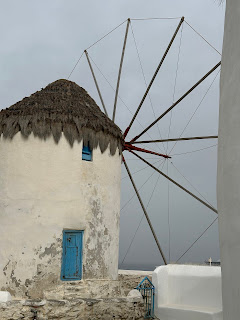Sorry to be so long in updating, but this is the first breather we've had since leaving Symphony.
We left smouldering Paros and arrived at Nafplion the next morning. We did not book any of the shore excursions and were planning to take the tender into town and walk around. The risk of showers was still over us and it didn't look too appealing. We weren't quite sure what was going on with the weather as through the morning the skies developed an odd tinge. At home, we would have said that a thunderstorm was coming, and going on that assumption, we decided to stay on board.
As it turned out, it was the Sahara Desert that was giving us grief. The high winds were coming from Africa and picking up the fine sand on their way. Most of it stayed in the air, but some fell on the outer decks of the ship and into the swimming pool. Here are some photos of the eerie afternoon skies:
So that was our visit to Nafplion. Maybe we'll see it again next time we are in the Greek Islands.
Our final port stop for the cruise was the island of Mykonos. We had never been here before either and were looking forward to a nice day.
We met up with our guide at the tender pier and started our walking tour around town. Up until the late 1960s, Mykonos was a sleepy island where the biggest industry was fishing. Then came Aristotle Onassis, bringing Jackie Kennedy with him. Rich people, movie stars and the like started to use Mykonos as a getaway spot, and because of that more and more people started to hear about the island. Now the main industry is tourism.
It still has that sleepy village feel about it in the back streets, but you can't turn a corner without finding a souvenir shop or a cafe or a clothing store.
 |
The cats here are also taken care of by the locals,
but they do some of their own fishing, too. |
Our walk took us across the back of 'Little Venice', given that name because the houses are literally built into the water. The owners of these houses used to open a door or gate to let in the boats and, in times of piracy, they would close them again so nobody could see what goods were going in or out of the building. They have done the same sort of thing in Venice for hundreds of years. Now most of these places are small restaurants or bars.
One of the most famous sites of the island is the Windmills standing on a hill just outside of the main town, or Chora. We were even lucky enough (for our 'scaffolding album') to find one under renovation. It is always windy on this hill, and the mills have traditionally been used to mill wheat into flour. The wheat is brought to the island from other parts of the Mediterranean as it certainly isn't grown on the island.
There was even a guy with his donkey, probably looking for people willing to pay for a photo opp. I happened to catch him as he and the donkey were leaving.
The tour ended here at the windmills, and we carried on by ourselves, map in hand. Our guide had said that it would be easy to get lost in the tiny passages, and she was right! We thought we were heading toward the shore at one point, and found that we had been going in precisely the wrong direction. Not that it was hard to retrace our steps and find our way back. We also found a few interesting little nooks and buildings along the way.

And that was most of our day in Mykonos. It is touristy, but it would be interesting to spend a few days exploring the town, the island, and especially the food. On our way back toward the pier, we passed a few of the island's cats, including this one. She barely even opened her eyes as we stopped.
We got our packing done early in the afternoon and discovered as we went to check in for our flight to Nice that the second leg had been cancelled and Lufthansa was finding an alternative routing for us. It ended up being an overnight in Frankfurt, so we had to rearrange things a bit. Fortunately we always have a foldable bag with us, so we used that to carry our pajamas and toothbrushes for the hotel. We booked into the Sheraton at the airport, as our flight to Nice was leaving at 7:40 a.m. So we ended up spending about 7 hours in the Lufthansa Lounge at Athens airport.
It wasn't until we arrived in Nice that we discovered the reason for the re-routing. The French air traffic controllers called a strike for Thursday afternoon, causing chaos for any flight within and into France. They called it off at the last minute, but by then the damage had been done. And the Tauck trip had 32 other guests stuck in Paris overnight for the same reason.
Ah, well, we arrived on Friday morning with no hiccups, even with our luggage, to start the next part of our adventure.
































































